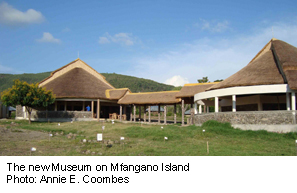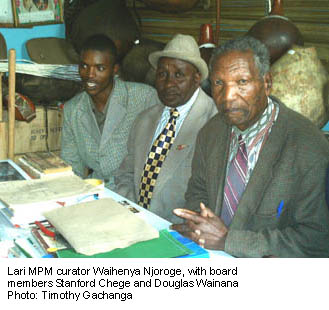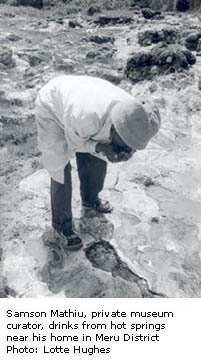You are here
- Home
- Research Projects
- Completed Research Projects
- Managing Heritage, Building Peace: Museums, memorialisation and the uses of memory in Kenya
- Project Partners, Managing Heritage Project
Project Partners, Managing Heritage Project
Project partners (in alphabetical order):
The following organisations are participating in the research.
ABASUBA COMMUNITY PEACE MUSEUM
Based on islands in Lake Victoria, this museum was founded by members of the Abasuba community to promote and protect their cultural and natural heritage. A new museum has recently opened, replacing an older one built by the community in 2000. The community works with the Trust for African Rock Art (TARA) and National Museums of Kenya (NMK) to protect and manage nearby rock art sites. The museum also promotes traditional methods of peace and conflict resolution.
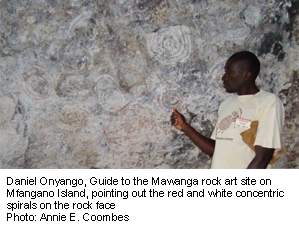
See the Trust for African Rock Art's (TARA) website for more information about their work
AKAMBA COMMUNITY PEACE MUSEUM
The Akamba Peace Museum is situated in the countryside near Machakos in a village called Kyanzasu. It was founded in 2002 by curator Munuve Mutisya, on land inherited from his father. The museum was one of the original group of peace museums involved in the Community Peace Museums Programme set up by Dr. Sultan Somjee, and is now part of the Community Peace Museums Heritage Foundation. The museum is particularly rich in material culture. Munuve, an accomplished musician and beader, has participated in collaborations with Native American beaders in the US, and has been active in working with local healers and elders in the community.
Link to photographs of Akamba Community Peace Museum at Kyanzasu
AEMBU COMMUNITY PEACE MUSEUM
This comes under the umbrella of the Community Peace Museums Heritage Foundation, which aims to foster community traditions of peace building, dialogue, healing and environmental care. Based near Aembu town, Embu District, it contains cultural artefacts connected with the Aembu community. Indigenous peace trees have been planted in the grounds of the museum. Museum staff are also working with local elders to conserve and protect two endangered sacred forests.
Profile of Aembu Community Peace Museum
LARI MEMORIAL PEACE MUSEUM
This small museum, in Kiambu District, was created in a grassroots effort to bring about reconciliation in a community that is still suffering the after-effects of the Lari Massacres of March 1953, during the Mau Mau emergency. This struggle divided Kenyans, and continues to do so. The management committee includes former Loyalists (Africans who were ‘loyal’ to the British colonial power) and former Mau Mau fighters. It is part of the Community Peace Museums Heritage Foundation, founded by ethnographer Dr Sultan Somjee.
Lari Memorial Peace Museum leaflet pdf (2,031 kb)
Exchange visit to Lari for community peace museums curators link
Lari Memorial Peace Museum website
NATIONAL MUSEUMS OF KENYA (NMK)
The state museum, whose main flagship museum and headquarters are in Nairobi, was founded in 1909. NMK also runs provincial museums across Kenya. It is empowered by law to regulate the preservation and protection of heritage sites, antiquities and monuments. Nairobi National Museum was recently refurbished, with major funding from the European Union; the renovation is ongoing. Our research focus is largely on the renovation of the history gallery, and discussions around it, as well as regional activities.
PORINI ASSOCIATION
An environmental conservation organization founded in 2005. Porini means ‘natural wilderness’ in Swahili. It sees effective environmental conservation as a function of cultural wisdom and commitment from local communities. Porini supports ecological and cultural regeneration through community ecological governance, community museums, promotion of indigenous knowledge and community empowerment, among other activities. It is pioneering community eco-mapping of forests in several areas.
SIMOO (Simba Maasai Outreach Organization)
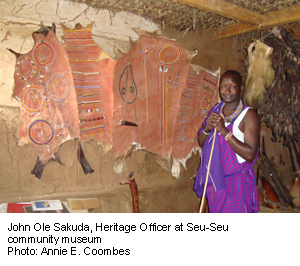 A community-based organization that works with Maasai pastoralist communities in Olosh-oibor villages, south of the Ngong Hills in Kajiado District. Its major objective is to improve the living standards of the poorest community members through integrated development. Activities include a food security programme, animal husbandry and development of water sources; education; women’s empowerment; lobbying and advocacy of indigenous peoples’ rights, and capacity building. It runs a community peace museum, and organises cultural shows.
A community-based organization that works with Maasai pastoralist communities in Olosh-oibor villages, south of the Ngong Hills in Kajiado District. Its major objective is to improve the living standards of the poorest community members through integrated development. Activities include a food security programme, animal husbandry and development of water sources; education; women’s empowerment; lobbying and advocacy of indigenous peoples’ rights, and capacity building. It runs a community peace museum, and organises cultural shows.
